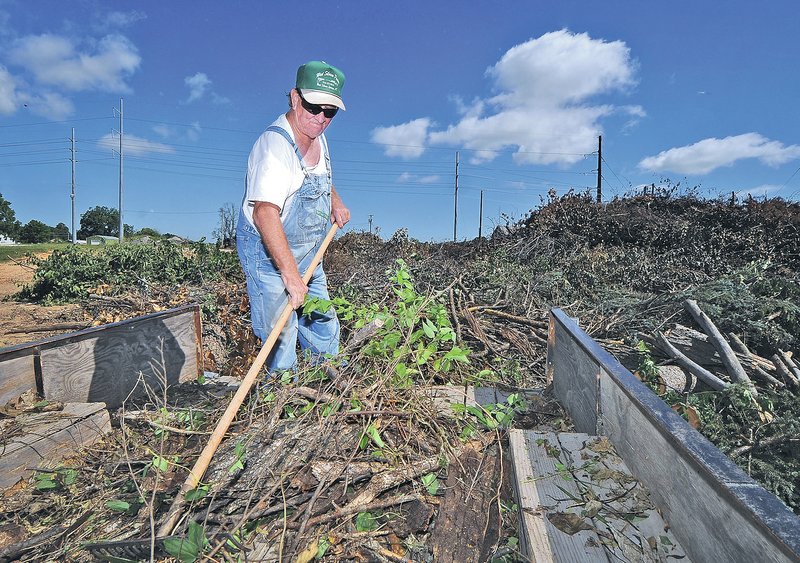ROGERS -- The volume of recycling at the Rogers Recycling Center has taken a significant downturn the past couple of years, said Jerrold Haley, center supervisor.
The center at 2300 N. Arkansas St. wasn't designed to be self-sustaining, but it was hoped it would generate enough revenue to help offset operation costs, according to city officials.
Fast Facts (w/logo
Recycling
"The number of tons has dropped about 20 percent the past couple of years. We saw the tonnage start to drop when Inland Service began using bigger recycling bins and collecting more of the recyclable materials," Haley said.
Inland began using the 64-gallon recycling cart in April 2011 and almost immediately recycling tonnage increased, according to Inland Service officials.
"Our recycling bin fills up faster than our trash bin," said Tom Jones, owner of Howard Jones Electric. "We have a full recycling bin every time, but our trash bin is usually about half full."
Jones said he was recycling before Inland Service supplied a bigger bin.
"The difference is we used to take some of our recycling material to the Rogers Recycling Center when we had the small green bins. We still take glass to the Rogers center, but most of the recyclables go in the Inland bin," Jones said.
Haley said it doesn't matter who recycles more: the city's center or Inland.
"So long as items that can be recycled are recycled is all that matters. It's important to keep as much recycled material out of the landfill as possible. Recycling adds years to the usefulness of the landfill and has other benefits as well," he said.
From January to June 2011, the Rogers center took in 846 tons of material. For the same period this year, the center accumulated 168 tons of recycled material, a difference of 678 tons, Haley said.
The center recycles paper, cardboard, plastic, glass, Styrofoam, yard waste and cooking oil.
"Not a lot of people know we recycle cooking oil, which can be converted and used to power cars and trucks," Haley said.
The center is the only place that accepts Styrofoam and yard waste, he said.
Recycling continues to increase in the area, but the number of tons of recycling material varies from month to month, said Clayton Shadrick, Inland division manager.
"You never know how much will be recycled in a month. It can change by several tons," Shadrick said.
Inland recycles paper, cardboard and plastic. It doesn't recycle glass, Styrofoam or cooking oil
"In 2013 we recycled between 32 and 38 tons a week. That's a lot of tonnage not going to the landfill," Shadrick said.
Recycling isn't a moneymaker for Inland Service any more than it is for the city, Shadrick said.
"We bill $13.76 a month for trash removal and recycling. Only $2.16 goes to recycling. We operate three recycling trucks a week and take the recyclable material to Marck Recycling Facility," Shadrick said.
Inland doesn't have to pay Marck to take the recycled material, nor does Marck pay Inland for the material.
"As I said, we recycle because it's the right thing to do, not because we make money from recycling," Shadrick said.
Most people associated with trash removal say it's important to keep as much recyclable material as possible out of the landfill. Marck takes in more recycling tonnage every year.
"We attribute most of the increase to continued growth in Northwest Arkansas," Wilson said.
Companies' representatives involved in trash removal and recycling agree it's a boost for the area to have the Tontitown landfill.
"Having the Tontitown landfill is very important to this area. I would say, if the landfill wasn't here, it woud be hard for some major companies to be in this area," Wilson said.
Without the Tontitown landfill, trash would have to be hauled to Oklahoma, Missouri or Kansas, according to local trash haulers, which would increase the cost of trash removal.
Katherine Benenati, public outreach and assistance division chief with the Arkansas Department of Environmental Quality, said getting a permit for a landfill can take months or years, depending on the area for the proposed landfill.
"Tontitown is in an area with karst geography. The regulations for permitting a landfill in a karst area have changed since Tontitown was built. It's hard to say whether another landfill would be permitted in such an area without seeing a specific plan," Benenati said.
Karst geography is underground limestone formations that can produce fissures or sinkholes.
NW News on 08/14/2014
